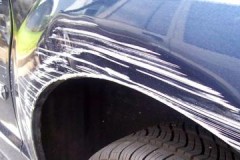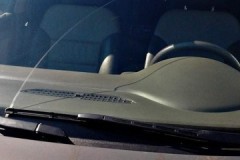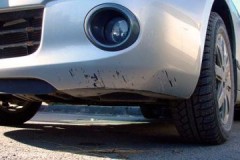Tips from experienced car owners on how to remove scratches from car plastic
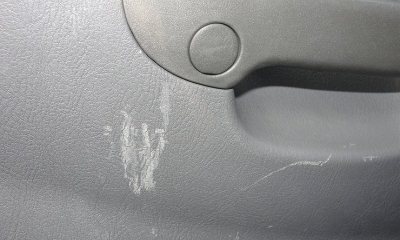 Even the most careful driver will not be able to avoid scratches on the plastic parts of the car.
Even the most careful driver will not be able to avoid scratches on the plastic parts of the car.
You can ignore them, or you can try to bring the damaged elements back to normal.
Read about how and by what means to remove small scuffs and deep scratches from the plastic outside and in the car interior, read the article.
Content
How to remove minor scuffs on the machine?
There are several ways to remove scratches from plastic car parts. They are polished, ground or heated. If you spend a little time, you can even deal with multiple defects on your own.
Polish
 Plastic polishes are special compounds based on silicones. The following are used as auxiliary additives:
Plastic polishes are special compounds based on silicones. The following are used as auxiliary additives:
- polymers,
- wax,
- antistatic agent,
- fragrances,
- humidifiers.
You can purchase polish in the form of:
- pastes,
- spray,
- foam,
- liquids.
The most convenient to use - aerosol polishes... In them, silicones are replaced by surfactants and aliphatic carbons.
You can also purchase formulations with antistatic and water-repellent effects. Each manufacturer includes instructions for their product, which may differ.
The universal algorithm of actions is as follows:
- The surface is prepared, dust and other contaminants are removed from it, and then dried.
- Holding the aerosol can at a distance of 20 cm from the part, spray the agent evenly. This method is suitable for getting rid of superficial scratches.
- If the damage is deep, choose a gel polish. It is squeezed onto plastic and left for a while. When the paste changes its color, start polishing.
- Rub the surface with a sponge or soft cloth. Often this material comes with a polish.
If it was not possible to completely restore the surface the first time, the polish is applied again. After finishing the treatment, the residues of the product are washed off with clean water.
Wax
Wax is a popular polish that has been used by drivers for quite some time.Unlike classic wax, the modern product contains auxiliary components that make it possible to better mask existing defects.
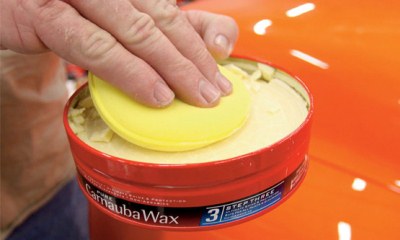 Mode of application:
Mode of application:
- wash and dry the area in need of treatment;
- a soft cloth is soaked in polishing wax and applied in a circular motion to the plastic;
- wait for the composition to dry, when white stains appear on the surface, they are removed with a dry clean cloth.
It is convenient to use wax. It has a thick consistency and adheres well to the surface.
Household or construction hair dryer
A hair dryer is often used to remove scratches from plastic. It helps to deal with deep defects. So that during processing the parts are not damaged, you must strictly follow the instructions.
Procedure:
- Degrease the area, remove all contamination from it.
- The building hair dryer is turned on, setting the temperature in the range of 200-400 degrees.
- The device is plugged in and the defects begin to warm up.
- The hairdryer needs to be smoothly driven from side to side all the time. You cannot hold your hand in one place. If the plastic is overheated, it will deform.
- After a short warm-up, the parts must be allowed to cool. You should not try to achieve results with the first approach.
- The warming up procedure is repeated after 10 minutes.
When working with a construction hairdryer, the following points should be considered:
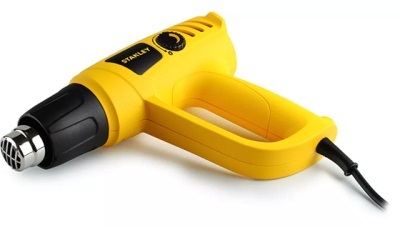 If the part is overheated, it will change its color. It is not very noticeable on black plastic, but gray or light-colored products will suffer significantly.
If the part is overheated, it will change its color. It is not very noticeable on black plastic, but gray or light-colored products will suffer significantly.- It is impossible to achieve a targeted effect of hot air on scratches. It will always hit adjacent parts.
When overheated, they deform and lose their functionality. For example, plastic buttons may stop working.
- If there is a pattern on the plastic, it may change.
- The fabric surrounding the plastic often burns through. Use masking tape to protect it.
Do not bring the hairdryer too close to the surface. The general recommendation is 20 cm. However, plastic parts differ in their structure and composition, so the gap can be increased or decreased during operation.
Sometimes you can find a recommendation for using a household hair dryer to combat scratches. on the plastic of the car. However, this method is ineffective, since it does not allow reaching the required temperature. At a distance of 5-10 cm, it will heat the plastic up to 70 degrees.
If you press it tightly, you can achieve an increase in temperature to 120 degrees (not for all models). With such indicators, success tends to zero.
Firstly, the heating is too weak, and secondly, working with a hairdryer pressed against the panel is simply inconvenient. The only thing that can be achieved in this way is to burn the part., causing the color to fade.
What if the damage is deep?
If the scratches are very deep, these methods and means will not be able to cope with them. You will either have to change the damaged part, or resort to radical solutions to the problem, including:
- Car painting... The composition is acquired to match the plastic part. The paint is carefully applied to the cleaned and degreased surface with a thin brush. When the scratch is filled, it is covered with a layer of clear varnish, and then a gloss or matt polish is applied. Before painting, the surface of the scratch must be leveled. If it is not smooth, the paint will not adhere well.
- Take advantage of vinyl, which is pulled over the damaged surface and heated with a hairdryer. This method allows you to mask even deep defects. However, over time, the film will become unusable, so it will need to be replaced.
- Drag the part with leather... If you do not have the skills to work with this material, you will have to contact specialists. This service will not be cheap, but the leather panel looks stylish and modern.
Features of surface treatment outside and in the car
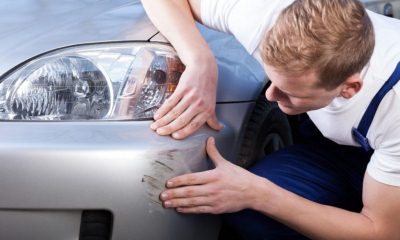 For the processing of parts located inside the cabin, no polishes and abrasive compositions intended for caring for the body are used. They contain particles that can disrupt the structure of the product and impair its appearance.
For the processing of parts located inside the cabin, no polishes and abrasive compositions intended for caring for the body are used. They contain particles that can disrupt the structure of the product and impair its appearance.
It is always more convenient to carry out work outside than from the inside, since it is possible to get full access for its high-quality polishing or heating.
The parts located in the cabin are made of softer plastic and are often glossy. Therefore, they can only be polished with soft, non-abrasive materials.
Plastic panels for the body and bumper are made mainly of thermosetting plastic in an alloy with propylene or fiberglass. This ensures their strength, so abrasive grinding attachments are used to remove scratches from them, which will be fatal for salon plastic.
Helpful information
Tips for Removing Scratches from Car Plastic:
- when using polishes, you need to take care of access to fresh air in the room - inhaling an excess amount of even the safest polishes will lead to dizziness and deterioration of well-being;
- before proceeding with the processing of a part located in a conspicuous place, you need to test the selected method on an unnecessary plastic product;
- when using polish, it is necessary to correctly calculate the amount of the product - its excess will negatively affect the quality of the work carried out;
- you need to apply the substance for processing parts on a cloth, and not on the plastic itself.
A lot of useful and important information about the ways and means of removing scratches on a car can be found here.
Related videos
How to remove scratches without painting the bumper, the video will tell you:
Conclusion
It is not difficult to get rid of scratches on the plastic of the car... They can be polished by yourself or smoothed with a hair dryer. These methods will not require significant financial investments. If the damage is significant, the parts are masked with dyes, vinyl or leather.

